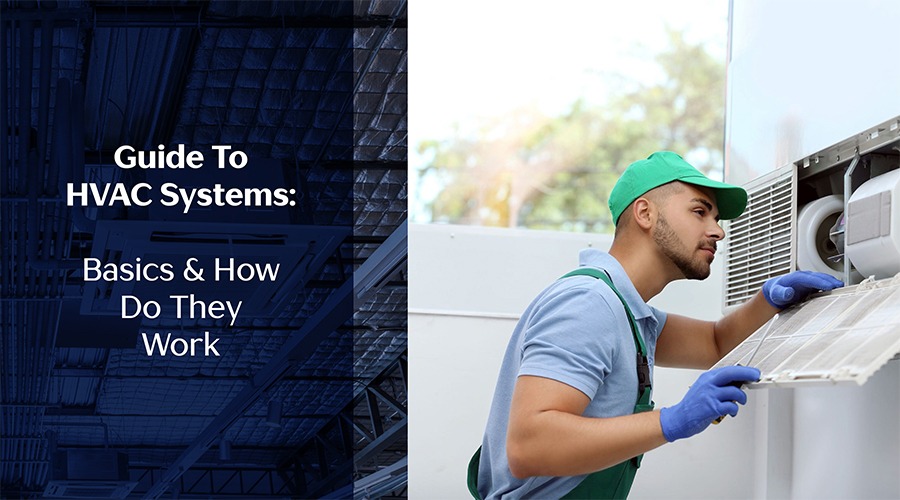
Guide To HVAC Systems: Basics & How Do They Work
Heating, Ventilation, and Air Conditioning (HVAC) systems are extremely important for keeping indoor environments comfortable, whether at home, in the office, or in commercial buildings. This guide will walk you through the basics of HVAC systems, including their main components, how they function, and the advantages of using Building Information Modeling (BIM) in their design including answering your questions like “How HVAC works”.
What Is an HVAC System?
An HVAC system is a mix of technologies that work together to control the temperature, humidity, and air quality inside a building. These heating and cooling systems are important for creating a comfortable and healthy indoor environment. You might see HVAC systems in a variety of places, from homes and offices to high-rise buildings and industrial sites.
HVAC System Basics Components
A Residential HVAC systems/ Commercial HVAC systems comprises several HVAC components that work together to control the indoor climate:
Thermostat: The control center that regulates the temperature setting.
Furnace: Heats the air using fuel sources like gas, oil, or electricity.
Heat Exchanger: Transfers heat from the furnace to the air.
Evaporator Coil: Cools the air by removing heat and moisture.
Condensing Unit: Releases the heat absorbed by the refrigerant from the indoor air.
Refrigerant Lines: Transport the refrigerant between components.
Duct-work: Distributes heated or cooled air throughout the building.
Ventilation System: Ensures fresh air intake and expels stale air.
How Does HVAC Components Work in a High-Rise Building?
In high-rise buildings, HVAC systems must address unique challenges such as variable occupancy levels, vertical air distribution, and differing climate conditions on various floors. Here’s how an HVAC system works in such buildings:
Zoning: The building is divided into zones with independent control systems to manage temperature and airflow efficiently.
Centralized Systems: Utilize a central plant for heating and cooling, distributing conditioned air or water through a network of ducts and pipes.
Variable Air Volume (VAV) Systems: Adjust airflow based on demand, improving energy efficiency and comfort.
Cooling Towers and Chillers: Used for large-scale cooling, where heat is expelled through cooling towers, and chillers cool the water circulated through the building.
Types of HVAC systems
1. Ducted HVAC Systems
Ducted systems use a network of ducts to distribute air from a central unit to various rooms. Common types include:
Split Systems: Consist of an indoor unit connected to an outdoor unit via refrigerant lines.
Packaged Systems: Combine heating and cooling components in a single outdoor unit, suitable for limited indoor space.
2. Ductless HVAC Systems
Ductless systems, also known as mini-split systems, do not require ductwork. Instead, they have an outdoor unit connected to one or more indoor units via refrigerant lines.
Some of the HVAC advantages include:
Flexibility: Ideal for retrofitting older buildings without existing ductwork.
Efficiency: Reduced energy loss compared to ducted systems.
Zoning Capabilities: Individual control of different areas.
Factors Affecting the Cost of a New HVAC basics
Several factors influence the cost of designing a new HVAC system:
Building Size and Layout: Larger or more complex layouts require more extensive systems.
System Type: Ducted vs. ductless, centralized vs. decentralized systems.
Energy Efficiency: High-efficiency systems typically have higher upfront costs but lower operating expenses.
Installation Complexity: Retrofitting existing structures can be more expensive than new installations.
Local Climate: Regions with extreme temperatures may require more robust systems.
Benefits of Using BIM in HVAC Design
Building Information Modeling (BIM) revolutionizes HVAC design by providing:
Improved Collaboration: Integrated platform for architects, engineers, and contractors.
Improved Accuracy: 3D models reduce errors and omissions in design.
Energy Efficiency Analysis: Simulate system performance and optimize energy use.
Cost Estimation: Accurate material and labor cost forecasting.
Lifecycle Management: Better maintenance and operation planning.
Book Your HVAC System Maintenance Appointment Today
Whether you’re constructing a new building or upgrading an existing system, a well-designed HVAC system is crucial for comfort and efficiency.
At BimOffis, our experts are ready to assist you with all your HVAC needs. Book your HVAC appointment today with BimOffis and experience the benefits of modern, efficient climate control solutions.

